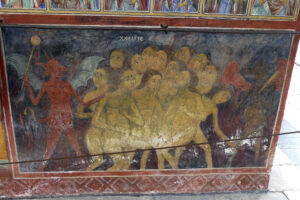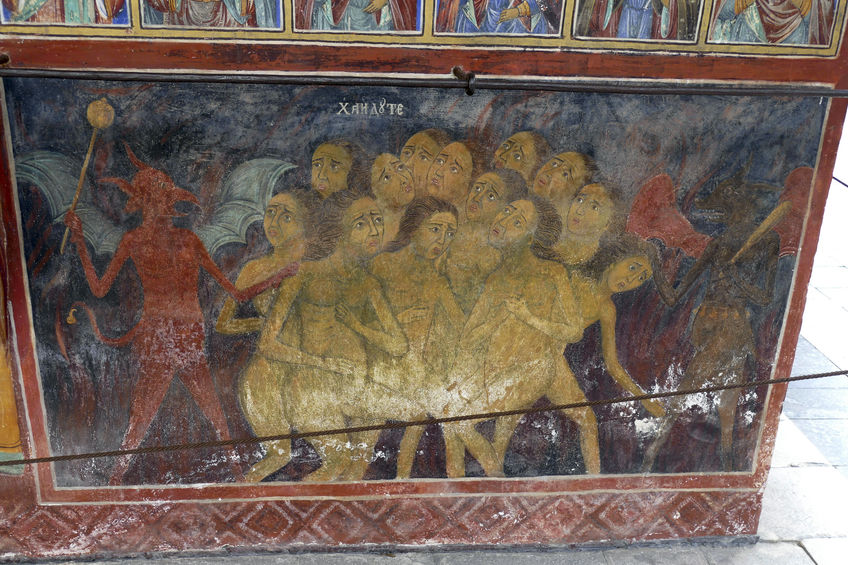
After Jonah admitted to the sailors that the tempestuous sea was because he was fleeing from the presence of the Lord, they threw him into the sea and it grew quiet again. In his distress from the belly of Sheol, he cried out to the Lord and the Lord answered him (Jonah 2:2). When Jacob wrongly believed that Joseph was killed by a fierce animal, he refused to be comforted by his children, saying he will go down to Sheol in mourning to his son (Genesis 37:34-35). When Isaiah prophesied against the king of Babylon, he said the shades who were leaders of the earth will be roused to greet him, stirred up from Sheol to meet him (Isaiah 14:9). Sheol occurs 65 times in the Old Testament and has a fairly wide range of meanings, which can make it difficult to determine which of its meanings is in view in a given OT passage. Although it clearly refers to some form of the afterlife, The International Standard Bible Encyclopedia said nowhere in the OT is Sheol described as a place of torment or punishment for the wicked.
The OT often uses Sheol and “grave” interchangeably, but that is not its only meaning. It can also mean “death” (Genesis 42:38; Psalm 89:48), “the next world” or “the nether world” (Psalm 86:13; Jonah 2:2) and “hell.” The Septuagint renders Sheol by the Greek word hádēs. The breadth of Sheol’s domain is emphasized in passages such as Proverbs 27:20; Isaiah 5:14; Habakkuk 2:5. It is impossible to return from Sheol. It has confining bars and dust (Job 17:16) and a large mouth to receive its inhabitants (Isaiah 5:14).
Not until after 333 BC was Sheol (Hades) conceived of as a place of torment and comfort. “The view of Hades as a place of confinement for the wicked (Revelations 20:13) until their destruction in Gehenna (Matthew 10:28; Revelations. 20:14–15) goes beyond the far more neutral OT usage of Sheol.” According to Desmond Alexander, in the journal Themelios, before that time Sheol, the realm of the dead, was where both the righteous and the wicked shared a common fate. After the Exile, the Hebrew view of the afterlife underwent various transformations. According to Joachim Jeremias in The Theological Dictionary of the New Testament, three significant changes occurred.
First, the belief of resurrection gave rise to the sense that the dead would not remain in Sheol forever (Isaiah 26:19). Second, Greek and Persian views of retribution after death led to a division of the underworld into different departments for the righteous and the wicked. According to Josephus, the Pharisees held this belief:
They also believe that souls have an immortal vigor in them, and that under the earth [in Sheol] there will be rewards or punishments, according as they have lived virtuously or viciously in this life; and the latter are to be detained in an everlasting prison, but that the former shall have power to revive and live again.
And third, The Greek concept of immortality led to the idea that the righteous went directly to heaven, while the wicked descended to Sheol, where they were punished. This belief was evident during the time of Jesus and can be seen in the parable of the rich man and Lazarus. When Lazarus died, he was carried by angels to Abraham’s side. When the rich man died, he went to Hades and was in torment (Luke 16:19-31). The depiction of Hades here in Luke corresponds to the average popular view of Jesus’s time.
The New Testament agrees that Hades was at the heart of the earth. The NT also agrees the time in Hades is limited. “Throughout the NT Hades serves only an interim purpose. It receives souls after death, and delivers them up again at the resurrection (Rev. 20:13).” The resurrection is the end of Hades (Revelation 20:14), and is replaced by Gehenna (Revelations 19:20; 20:10, 14f) as the final place of punishment.
Desmond Alexander said the belief that Sheol was the final abode of the wicked was in keeping with the idea that death was punitive rather than natural. “Since mankind was considered to be under divine condemnation the normal consequence of dying was imprisonment in a dark, gloomy region from which no one could ever escape. To go down to Sheol was to suffer a ‘bad’ death.”
An implication of the resurrection is that the righteous remain in the realm of the dead until divinely raised to life again. So therefore, there must be some form of an intermediate state between death and resurrection. If Sheol is understood to be the abode of the wicked alone, the righteous must exist elsewhere prior to their resurrection. “Unfortunately, the Old Testament reveals little regarding the precise nature of the intermediate abode of the righteous.”
One of the few clues regarding the OT sense of what happens with the righteous after death is the expression ‘to be gathered to one’s people’ (Genesis 25:8, 17; 35:29; 49:33; Numbers 27:13; 31:2; Deuteronomy 32:50) or ‘to be gathered to one’s fathers’ (Judges 2:10; 2 Kings 22:20; 2 Chronicles 34:28). These figures of speech do not refer to burial in the grave of the fathers, or an ancestral tomb. Abraham, Aaron and Moses were not united with their father in the grave as Genesis 25:8, Numbers 27:13, and Deuteronomy 32:50 indicate. Death is sometimes described as falling asleep (Psalm 13:3; Daniel 12:2; 1 Thessalonians 4:13-14), whereas the resurrection is described as awakening (2 Kings 4:31; Job 14:12; Isaiah 26:19; Daniel 12:2). This suggests the intermediate state of the righteous is one of tranquility and peace, as in the parable of Lazarus and the rich man.
Taking these factors into account we may now be in a better position to appreciate the somewhat ambivalent attitude, noted above, of the Old Testament writers towards Sheol. Although all men may have been viewed as initially descending there on dying, the fact that the righteous would subsequently be resurrected, leaving behind the wicked, possibly explains why Sheol is generally presented in quite negative terms. Whereas the righteous would eventually enter into God’s presence the wicked continued to languish in the depths of Sheol. Thus, in spite of the temporary sojourn of the righteous there, Sheol represented for the Hebrews the ultimate and lasting abode of those who were excluded from the divine presence.
Desmond Alexander ended his article with the following conclusions. First, the belief that in pre-Exilic period the Old Testament the Hebrew view afterlife was that it was a natural outcome of man’s mortality, and as a consequence, showed little interest in the afterlife, should be rejected. Second, it seems likely that Sheol frequently represented the nether world, the continuing realm of the ungodly. And thirdly, while the wicked remained in the dark, silent region of Sheol, the righteous lived in the hope that God would deliver them from the power of death and take them to himself, as Psalm 49:15 declares: “But God will ransom my soul from the power of Sheol, for he will receive me.”
While Sheol is most often translated as “Hades” in the Septuagint, a term that refers to the netherworld in Greek mythology, there are similarities as well as differences. Hades and Sheol are both place people must descend to and both locations are escape proof. But only the wicked descend to Hades (1 Peter 3:19). The torments of Hades, which was later called hell, were not more imaginatively described until postbibilical times.
Evidence for this development is the phrase, “He descended into Hell (Hades),” which is present in the Apostles’ Creed, but missing in the Roman Creed (R). In Early Christian Creeds, J.N.D. Kelly said the belief that Christ spent the interval between his death on the cross and the resurrection in the underworld was commonplace in Christian teaching from the earliest times. Apart from it being within the minds of the New Testament writers, as some have argued, the Descent was specifically mentioned by Ignatius, Polycarp, Irenaeus, Tertullian and others. The first appearance of the phrase in a variant of R was within the Aquilean creed, as follows:
I believe in God the Father almighty, invisible and impassible; And in Christ Jesus, his only Son, our Lord, who was born by the Holy Spirit from the Virgin Mary, crucified under Pontius Pilate and buried, he descended to hell, on the third day he rose again from the dead, he ascended to heaven, he sits at the Father’s right hand, thence he will come to judge living and dead; And in the Holy Spirit, the Holy Church, the remission of sins, the resurrection of this flesh.
Kelly said the doctrine of the Descent had nothing to do with pagan mythology. Rather, it was the natural corollary of Judaeo-Christian ideas about the condition of the soul after death. “To say that Jesus Christ had died, or that He had been buried, was equivalent to saying that He has passed to Sheol.” By the time the Descent became an accepted article of the creed, a different set of ideas was associated with it. Rufinius argued that Christ consented to die in order that He might spoil death, which was atoned for in His victorious combat with the Devil in the underworld. “For him, it would appear, the underworld meant hell, and the descent was coming to be viewed as the occasion of the redemption, not just of the patriarchs of old, but of mankind in general.”
The understanding of the afterlife in Sheol developed from a simple sense of the grave or the place where righteous and wicked people went when they died, to the sense of the ultimate place where wicked people were excluded from the divine presence. Passages in the Old Testament indicate the wide range of meanings for Sheol that support this conclusion. After the Exile, the Hebrew view of the afterlife underwent changes. These changes included a growing belief in a resurrection of the righteous, the immortality of the soul, and the distinction between the wicked and righteous, with the wicked receiving punishment and the righteous being rewarded. The translation of the Old Testament into Greek, where the Greek word Hades was substituted for the Hebrew word Sheol in the Septuagint, may have also helped transpose Greek and Persian ideas of the afterlife or Hades onto the OT sense of Sheol.
There were similarities and differences between Hades and Sheol. Although they were both places people must descend to and both locations were escape proof, only the wicked descended to Hades (1 Peter 3:19). The torments of Hades or hell would not happen to the righteous, who were in heaven or in a peaceful intermediate state awaiting their resurrection. The resurrection of Christ added another wrinkle to the distinction, where Christ’s true death meant he himself descended to Hades. While he was there, it was said he overcame death and released the righteous from their imprisonment. In the early days of the church, the Descent became an occasion for the redemption of the righteous and Christ’s victory over the Devil.
Adding the phrase “He descended into hell,” to the Apostles’ Creed was an uncontroversial elaboration of what Christ did between 3 pm Friday and his resurrection Sunday morning. The distance in time and culture from the early church then leads to misunderstanding, as with the disputes around the Contemporary Christian singer Kari Jobe and her song, “Forever.” For further discussion of the descent into Hell, the Roman Creed and the Apostles’ Creed, see “Descent Into Hell,” “Christian, What Do You Believe?” and “The Old Roman Creed.”





